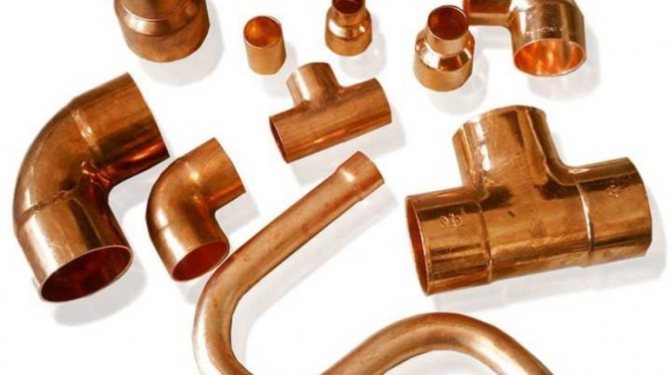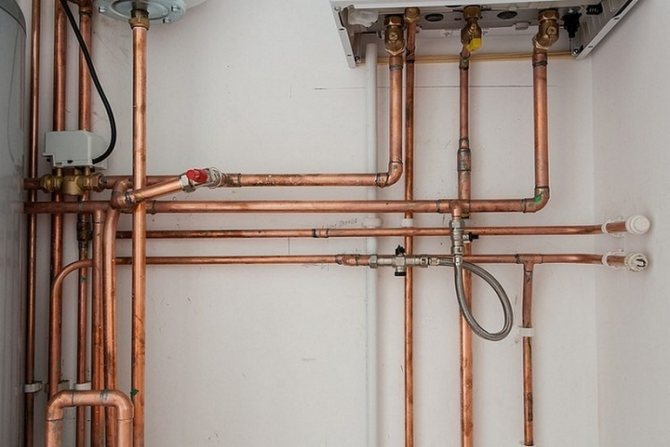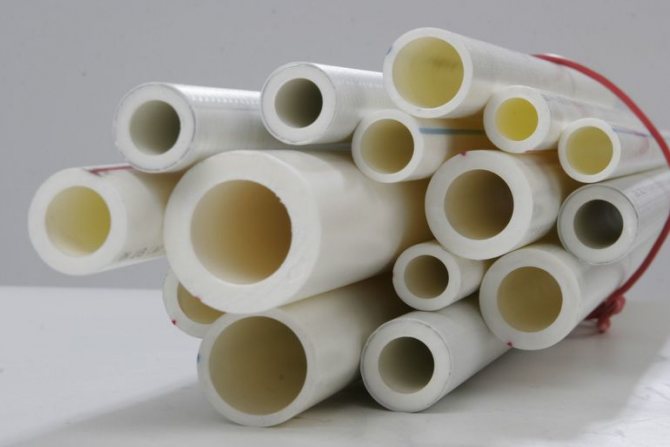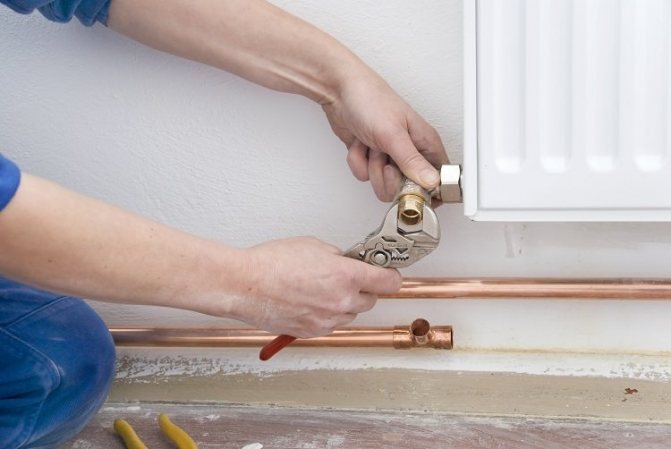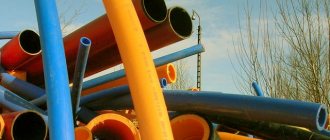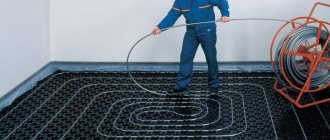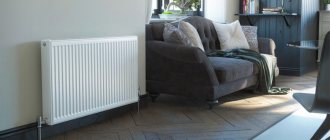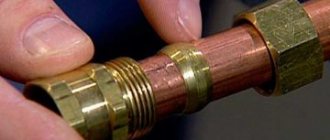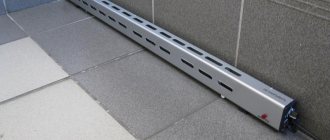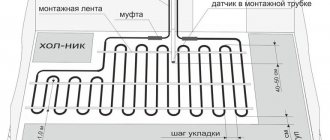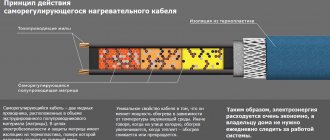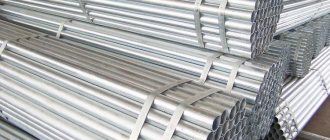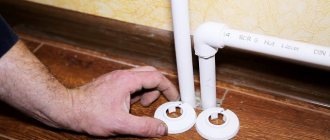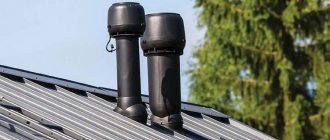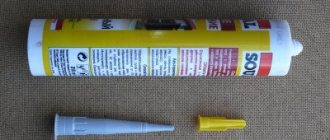Copper is an excellent material for gas pipeline systems, heating and so on. Also, copper pipes are widely used in the installation of air conditioners. A wide range of applications is determined by such qualities of the material as resistance to high temperatures of the passing medium, resistance to corrosion, durability. Installation of copper pipes is carried out in two main ways: soldering or crimp fittings.
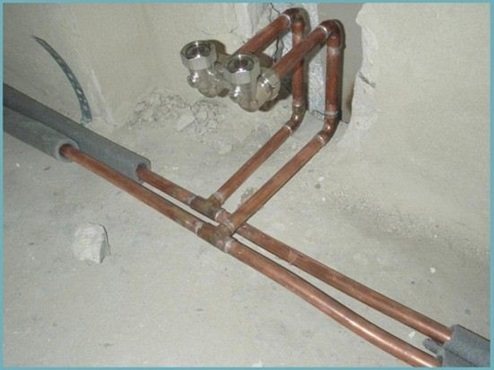
Assembly of a pipeline from pipes made of copper
Material characteristics
Copper pipe for water is a kind of rolled metal made of copper, which is a long-shaped hollow billet with a circular cross-section and a uniform wall thickness. It is produced in rods from 1 m to 6 m in length or in coils of 15, 25 and 50 m.
The diameter of the products varies from 6 to 267 mm, the wall thickness is from 0.5 mm to 3 mm. Despite the fact that copper tubular products have a thinner wall than steel, its inner diameter is larger, so it is able to withstand the same working pressure of the environment as steel products with a similar outer diameter.
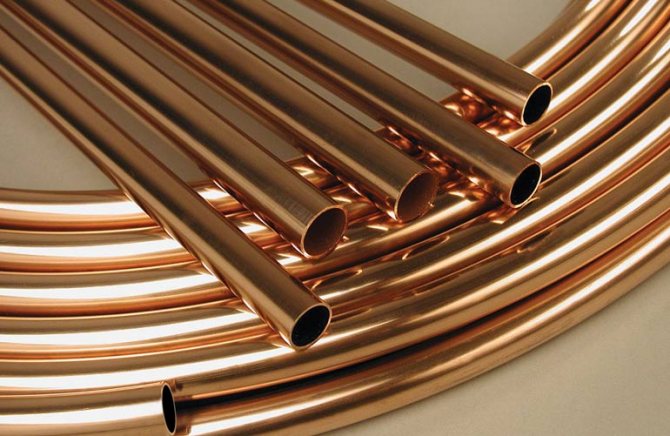

The technical characteristics of copper pipes depend on the properties of the copper grade. Usually, in production, pure copper or its alloys are used, to which a small amount of alloying components (M1r, M1f) are added. The type and amount of impurities in alloys has a significant effect on the mechanical, technological, mechanical and operational characteristics of pipes.
The addition of zinc, tin, iron and lead increase the strength, elasticity and flexibility of the material, acidification with phosphorus increases the corrosion resistance of the metal. To increase the mechanical resistance and antifriction properties, aluminum and beryllium are used. To eliminate the negative impact of undesirable impurities, manganese is introduced into the alloy composition.
Soldering connections
Connecting water distribution elements with copper pipes is a simple skill. Even a beginner is able to learn how to solder a pipe with his own hands in just half an hour. The recipe for success depends more than half on the thoroughness of the preparatory work. If you perform two steps correctly (cleaning the joints and heating), then the solder will complete everything by itself. When the elements are quite hot, the molten solder, due to capillary wetting, penetrates the joint and covers the mating surfaces.
After marking and cutting the installation elements, it is necessary to remove burrs and prepare pipes and fittings for brazing. To do this, you need to clean the mating areas with emery cloth and brushes, even if they look clean. After that, flux is applied to the treated areas. The process of soldering elements can be divided into the following stages:
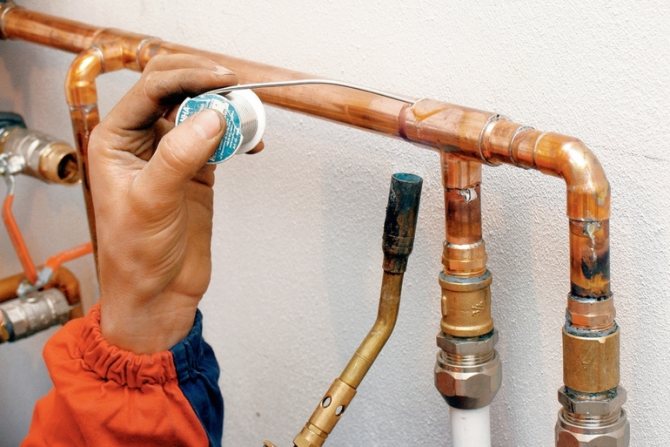

Brazing copper pipes
- Assembling the connection.
- Removal of excess flux.
- Heating the joint with a propane burner by moving the torch along the interface for a uniform temperature rise in the joint.
- Hold the solder on the joint opposite the flame until it melts and fills the joint.
- Stress protection of the connection until the solder solidifies.
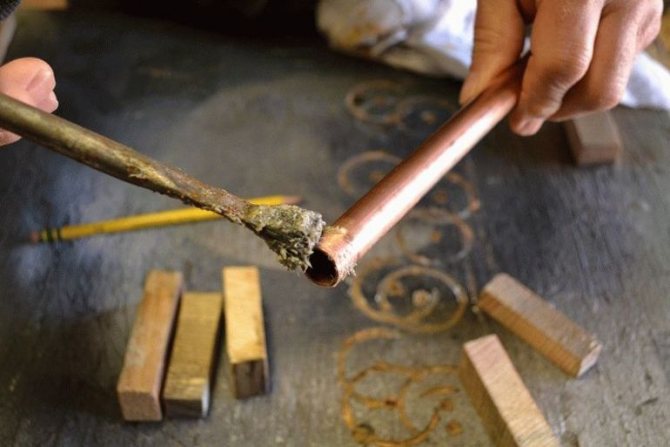

As a rule, it is much easier to first clean and flux all the details of the future water supply section, and then begin to solder them. It should be remembered that the hottest point of the torch is at its tip. There is no need to heat the pipe, it is enough to heat the fitting to raise the temperature of the entire joint due to the high heat transfer of copper.Solder will never leak into an area colder than its melting point, so it is always important to achieve uniform heating of the joint. Soldering of pipelines filled with water is not possible. To work, it is necessary to drain the water and dry the tubes in the heating zone.
Correctly and carefully soldered copper plumbing has an almost unlimited lifespan. Despite the fact that plastic systems have been leading the plumbing market in recent decades, traditional copper is gaining more and more supporters.
The cheapness of polymers is obvious only for relatively short service lives, so the number of people who are inclined to pay more for pipes, if only because they no longer think about them, is growing.
Regulatory requirements
The technical conditions for the production of thick-walled pressed and cold-worked copper tubular products are regulated by GOST 617-2006, drawn thin-walled GOST 11383-75. The high precision of manufacturing and finishing of copper pipes is determined by GOST 26877-2008 Metal products. Methods for measuring shape deviations. Primary copper grades and alloys must comply with GOST 859-2001. The chemical composition of alloys, assortment, technical requirements, marking, rules of acceptance, control and testing are established by GOST R 52318-2005.
Production
Seamless copper products are used for the construction of water supply and heating pipelines. They are manufactured using three technologies:
- Cold rolling - deformation of a metal blank occurs when passing between rotating rolls. A through hole is created using a stitching method. Then the sleeve is calibrated to the desired dimensions.
- Cold drawing - based on pulling the workpiece through a drawing tool (draw) with a special channel tapering along its length. In the process of drawing, the metal is compressed to the required geometric parameters and stretched along its length.
- Hot pressing - production of a pipe by extrusion (extrusion) through the die outlet.
In industrial production, one of these technologies or a combination of them can be used. The composition of equipment and technological operations may have some differences, but the main manufacturing process always consists of the following stages:
- Preparation of the workpiece.
- Cold rolling or drawing or hot pressing.
- Heat treatment.
- Lubrication of pipes and tools.
- Finished and intermediate products processing.
- Cutting into measured pieces or winding into coils.
- Quality control of finished products.
Installation
When installing a copper water supply system, one of the main features of copper products must be taken into account - their plasticity. It simplifies installation work, as it makes it possible to bend pipe products and give the structure the desired configuration. However, such ductile pipelines can bend over time. To avoid this type of deformation, the water supply lines should be well fixed with the help of supports or the installation of special fasteners (brackets).
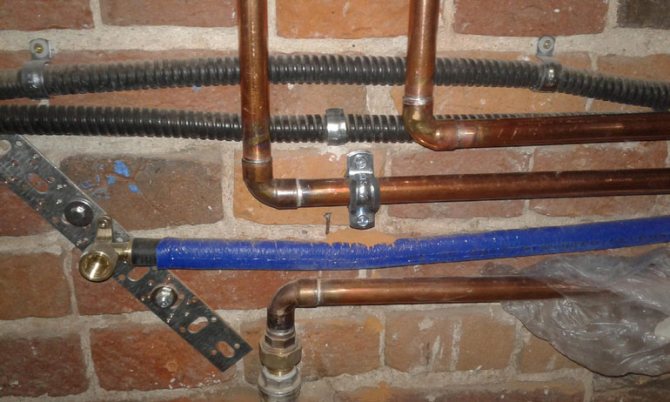

If the pipeline goes deep into the wall material, it is recommended to use PVC-sheathed copper pipes. It performs two functions at the same time: thermal insulation and anti-corrosion protection, preventing damage to either the pipeline or the plaster.
Installation tools
Working with copper water pipes is pretty straightforward. It will require standard tools, which are always available from the home craftsman: a measuring tape, marker, hammer and adjustable wrench, as well as several specialized devices to facilitate the process. The pipes themselves are easy to cut using a conventional hacksaw. But if you use a special device, you can get a smooth cut without burrs. For folds, the following methods are used:
- filling with fine sand before molding (traditional technique);
- using a special spring (suitable for working with long pipes);
- using a pipe bender.
You will also need soldering fixtures for installation. Any such work should be carried out in compliance with safety precautions. Taking into account the latest requirements, the list of necessary devices includes:
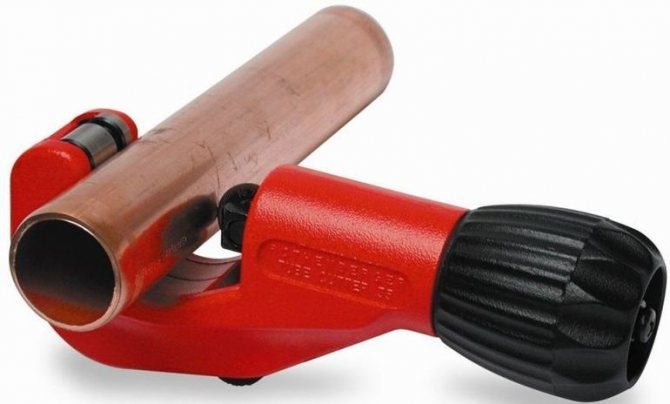

Plumbing materials and tools
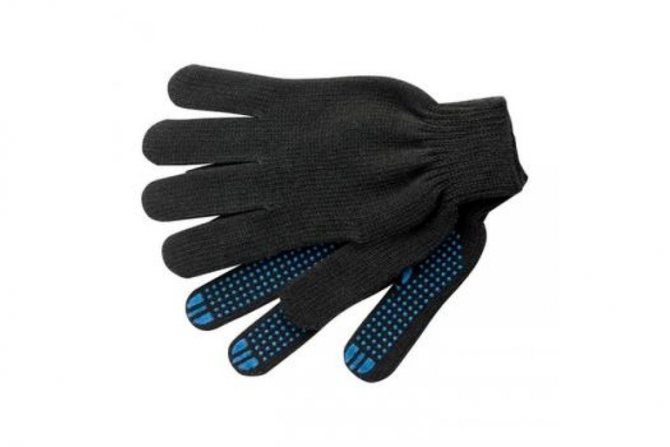

- eye protection;
- thick gloves;
- fireproof fabric;
- fire extinguisher;
- copper pipe;
- pipeline accessories;
- pipe cutter;
- metal brush;
- sandpaper;
- propane burner and regulator with built-in igniter;
- soldering flux or paste;
- lead-free solder wire;
- napkins or rags.
Pros and cons of copper pipes
Copper tubular products have the following advantages:
- High strength and wear resistance.
- Resistant to corrosion and UV radiation.
- High indicators of plasticity. Pipes bend well, which makes it possible to assemble structures without the use of fittings.
- Resistant to sudden temperature changes and pressure fluctuations.
- Frost resistance. Pipes do not collapse after freezing.
- Attractive appearance.
- Durability.
- Inertness in relation to aggressive environments.
- Heat resistance.
- Gas tightness.
- Environmental friendliness. Copper alloys do not emit toxic substances and are stable to oxidation.
- Antibacterial property.
- Light weight, easy to install and transport.
- No build-up on the inner walls occurs when the water flows.
The disadvantages of using copper pipes for a water supply system include:
- Quite a high cost.
- High electrical conductivity.
- Difficulty combining with other types of pipes (plastic, steel, aluminum).
- When connecting pipeline parts, special equipment (a gas burner or a soldering iron) and certain skills are required.
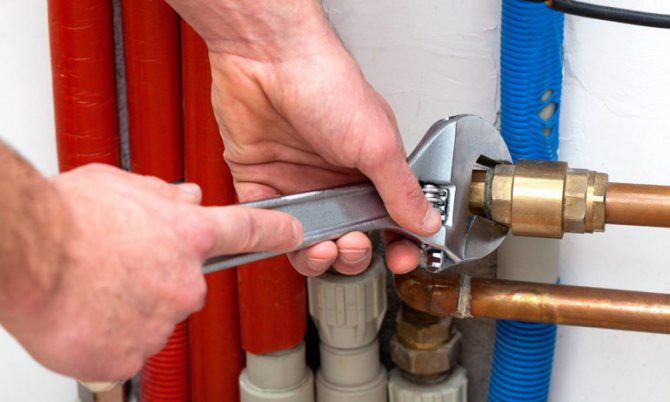

Features of installing pipes for water supply
Installation of a copper water supply system for cold and hot water does not differ in technology. However, you should pay attention to the appearance of pipelines and corresponding fittings: parts intended for hot water are insulated with PVC foil. Installation of copper pipes for water supply can be carried out in one of the following ways:
- Using threaded fittings.
- With the use of soldering.
Collet connection with threaded fittings is the easiest and most affordable way to install with your own hands.
Threaded fittings create detachable connections that can be unscrewed or twisted many times as needed. In order to carry out the installation, you must:
- Slide the crimp nut onto the pipes.
- Put on the crimp ring on top.
- Connect the elements together.
- Tighten the nut.
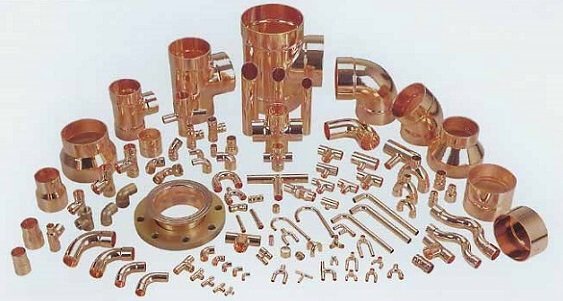

Copper fittings
The crimp ring is responsible for the tightness of the connection, therefore it cannot be reused. If the connection had to be untwisted, the rubber ring should be replaced with a new one. Copper pipes can be bent in any direction, and therefore it is possible to save on the number of fittings.
Soldering is a somewhat more complex installation method, however, it is quite doable with your own hands. You must be careful and follow all safety measures when working with open flames. The connection itself consists of the following stages:
- Sanding pipe ends and fittings with sandpaper to bare metal.
- A thin layer of soldering flux is applied with a brush.
- The pipe is inserted into the fitting up to the maximum mark.
- The junction is heated with a gas burner or a building hairdryer. It is very important to evenly warm up the elements to be connected; for this it is recommended to use a blowtorch with two torches.
- When the heating temperature is sufficient to melt the solder, it is injected into the joint.
- After curing, excess flux can be removed.
Copper fittings with pre-provided solder in a special groove are on sale. This simplifies do-it-yourself installation: you just need to insert the end of the pipeline lubricated with flux and heat it to the required temperature. The solder will melt and flow into the gap between the pipe and fitting, creating a secure connection.
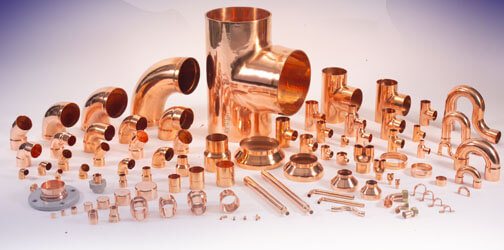

Copper pipe fittings
Views
Copper pipe is available in two types:
- Annealed - heat treated (annealed). The workpiece is heated up to 550 ° C - 650 ° C for 60 - 90 minutes, and then gradually cooled down (tempered), as a result of which it acquires elasticity, resistance to high humidity, sudden changes in temperature and pressure.
- Unannealed - more durable, but less elastic.
For thermal insulation and to prevent the appearance of condensation on the outer surface of the product, they can be covered with a polymer shell.
Advantages and disadvantages
Copper has been used to safely transport drinking water for thousands of years. It is the oldest piping material and has an undeniable reputation for being the most durable and resistant. In addition to time-tested reliability, the main advantages include:


Advantages and disadvantages of copper pipes
- Versatility. Meets safety requirements over a wide range of temperatures and pressures.
- Hygiene. Does not release unknown substances into the water and does not allow gases to diffuse through the walls of the installations. This means that foreign odors and other influences cannot degrade the quality of the water.
- Recyclability. In case of demolition or renovation of the building, 100% recycling is possible.
- Aesthetics. Copper plumbing can serve as an expressive design element, so there is no need to hide the system in the wall.
- Uniformity of standards. All pipes and fittings available on the market are interchangeable.
There are no perfect plumbing materials, each has its own pros and cons. There are always technical conditions, features of the chemical composition of water, installation problems that exclude the possibility of using one or another installation. These features also apply to the use of copper pipelines. List of disadvantages limiting the use of copper:
- Wide range of quality pipes and fittings. The presence on the market of budget options that do not have the listed advantages.
- Sensitivity to certain types of water. Despite its outstanding corrosion resistance, copper is able to change its properties when in contact with highly acidic water. This threatens the appearance of a taste in the water and the formation of fistulas in the pipes.
- Relatively noticeable sensitivity to high pressure in the water supply system.
What is better copper or polypropylene pipes?
For an objective comparison, consider the basic indicators of both types of materials, characteristic of all water pipes:
- Operational properties. Copper, unlike polymeric materials, is not subject to the damaging effects of chlorinated tap water. Chlorine is a strong oxidant that corrodes plastic, and on the inner surfaces of copper pipes forms a thin protective layer - a patina, which significantly increases their service life. Destructive for plastic is ultraviolet radiation and subzero temperatures, while copper is resistant to sunlight when the temperature drops. its walls expand without loss of integrity.
- System reliability. The joints of the elements of the plastic pipeline are less reliable than the copper one.
- Lifetime. Copper and polypropylene pipelines can be operated for at least 50 years.
- Price.The cost of copper products is high, this is due to the high cost of primary copper and the laboriousness of the production process. Of course, polypropylene pipes are several times cheaper. But, when assembling plumbing systems, polypropylene fittings are required, the cost of which is much more than copper fittings. In addition, plastic pipelines require additional elements to increase their reliability.
As a result, it turns out that the cost of copper plumbing is generally lower than plastic.
Selection Tips
Unannealed copper rolled products are produced in measured lengths, and if it is necessary to make an extended and complex wiring with a small number of joints, then it is better to choose practical coils of annealed copper pipes of the same diameter and close in price. The performance of the system will not be affected when properly assembled.
approximate price
The cost of copper pipes depends on the following parameters:
- Sizes. The larger the diameter, the more expensive the product.
- Manufacturing firms. Products from European countries are 15-20% more expensive than their counterparts in Russia.
Copper tubular products are the most expensive of the entire range of materials for the construction of engineering networks. For example, with a diameter of 15 mm and a wall thickness of 1 mm, the price of a running meter will be 250 - 300 rubles.
Connection methods
The installation of these products can be carried out in two ways: by threaded connection or by soldering. Copper and alloys formed on its basis can be joined by both high-temperature and low-temperature brazing. For water supply systems, low-temperature brazing is mainly used with the use of various solders, with the exception of lead-tin. They contain a large proportion of lead, which cannot be used for brazing drinking water pipelines.
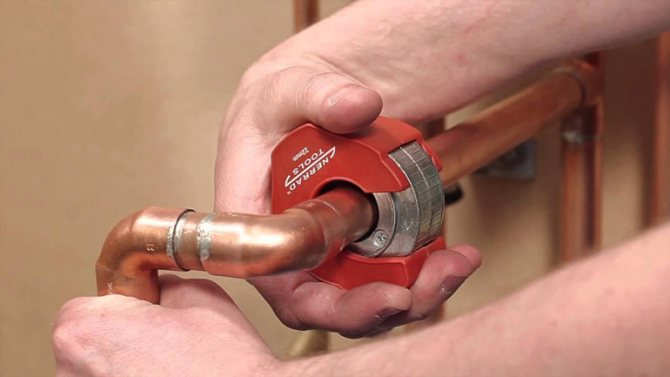

For the assembly of such systems, it is better to choose tin-copper or silver-containing solders. They create a good quality seam and meet all the requirements for the strength, reliability and durability of plumbing systems. As a flux, you can take a rosin-vaseline paste, which includes rosin, zinc chloride and technical vaseline. It has an easy-to-apply pasty consistency.
Installation of copper pipes for water supply
Before starting work, you need to draw up a diagram of the future plumbing structure and, on its basis, calculate the footage of rolled pipes and the number of connecting elements (press couplings, tees, bends, adapters, etc.).
Required tools and materials
To carry out the installation of rolled pipes made of copper alloy, you need to prepare a set of tools, consisting of:
- Hacksaws for metal or pipe cutters.
- Pliers.
- Manual calibrator.
- Wrenches or a gas burner (for heating the pipe section when soldering parts).
- File.
For joining pipe sections, depending on the selected connection method, the following materials will be required:
- Fitting.
- FUM - tape for sealing the joints of detachable fittings.
- Solder and flux (in the case of soldering products).
Precautions
Soldering of copper products is carried out when they are heated to high temperatures, therefore, when working, it is necessary to wear protective clothing and use a fire shield. Remove rubber or plastic braids from the parts to be connected in the contact area. For taps to be installed, the valve must be unscrewed so that the O-rings do not melt.
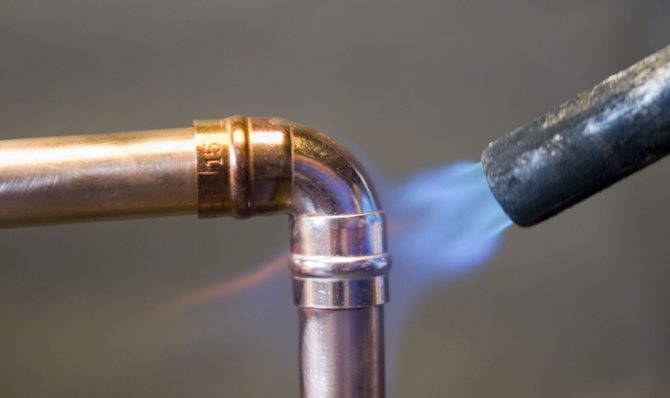

When brazing copper products in an already installed pipeline system, all shut-off valves should be opened so that the pressure level in the pipes does not exceed the permissible values due to heating of some areas.
Work progress
Docking of pipe sections using fittings is performed in the following sequence:
- Cut off pipe sections to the required size.
- If the water supply is assembled from copper pipes with PVC insulation, then this layer should be removed at the ends of the products.
- Deburr the cutting line with a file.
- Remove the chamfer.
- Put on the prepared part alternately the union nut and the compression ring.
- Engage the fitting with the nut and tighten the threads first by hand and then with a wrench.
- In places where the installation of a transition fitting from a copper pipe to a steel one is carried out, the tightness of the joints is ensured by the use of FUM - tape.
When connecting pipes by soldering with your own hands, you need to follow the precautions described above and have certain skills. The preparation process and the soldering itself includes the following steps:
- Cutting the required pipe sections using a pipe cutter or a hacksaw for metal.
- Removal at their ends of the thermal insulation layer (if any) and the formed burrs.
- Removal of the oxide film in the soldering zone with a fine abrasive cloth.
- Sanding the fitting.
- Flux coating on the outer surface of the parts.
- Insert the end of the pipe into the fitting so that there is a gap of no more than 0.4 mm between the parts.
- Warming up the contact zone of the gas burner elements (pictured below).
- Inserting solder into the gap between the fitting and the end of the copper pipe.
- Soldering the seam.
- Flushing the system from flux particles.
The process of brazing copper tubular products can be viewed in the video:
Installation features
Installation by soldering forms one-piece connections that do not require maintenance and are considered the most reliable in operation. But, in order to solder a copper water supply system, you must have sufficient experience in this type of work and relevant knowledge. Beginner masters can use the following recommendations:
- Do not clean copper products with abrasive cleaners, coarse sandpaper or a wire brush, as these will scratch the copper. Deep scratches on the surface interfere with the soldering process.
- Flux is a fairly aggressive substance with high chemical activity. You need to apply it in a thin layer using a brush. If surplus does not appear on the surface, at the end of the process of joining the parts, then they must be removed immediately.
- The contact zone should be heated sufficiently, but not excessively, so as to prevent the metal from melting. The solder itself should not be heated. It should be applied to the heated surface of the part - if it begins to melt, then you can start soldering.
- It is necessary to bend the pipes so as to prevent kinks and twisting.
- The installation of copper products should be carried out in front of aluminum or steel sections in the direction of the water flow to prevent rapid corrosion of the latter.
- For the transition from copper pipes to sections made of other metals, it is recommended to use fittings made of brass, bronze or stainless steel.
Features of installing a heating system using copper pipes
The installation of copper pipes for the heating system begins with preparatory work. The material can be easily bent and cut, but it must be done in the correct way. Key recommendations:
- Before installation, it is necessary to cut the pipes into pieces of the required length.
- It is better to cut pipes for heating with a pipe cutter or a hacksaw for metal.
- The inner surface of the pipelines must be free of burrs and metal shavings. To complete this task, you will need a file and a scraper.
- The cut point must be leveled, especially in cases where the cutting was carried out with a hacksaw for metal, which slightly deforms the pipe.
- You can bend a tubular product manually or using a special tool.
- If the heating system has particularly complex curved sections, it is recommended to use a pipe bender.Such a bend will protect the material from unwanted creases, which can subsequently become a place of corrosion.
- Products should be bent with the minimum allowable radius.
- The bending radius when working with a pipe cutter must be at least 3.5 times the diameter of the pipeline. If the pipes are bent by hand, the bending radius should be at least 8 diameters.
Heating system with copper pipes
The connection of the elements of the copper heating system is carried out in two already known ways:
- Compression fittings;
- Soldering method.
Due to the fact that copper can be easily bent, installation is simple and requires a small number of fittings. However, it is necessary to remember about some rules for combining materials in a heating system.
Copper pipes must not be connected to aluminum radiators.
If the use of aluminum radiators cannot be avoided, a transition must be made through a steel pipe. This will help to avoid the onset of corrosion when copper and aluminum join. As for radiators made of other materials, for example, steel or cast iron, such problems do not arise.

